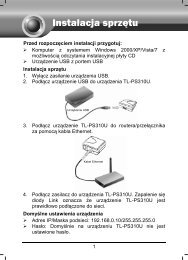TL-WR542G 54M Wireless Router - TP-Link
TL-WR542G 54M Wireless Router - TP-Link
TL-WR542G 54M Wireless Router - TP-Link
You also want an ePaper? Increase the reach of your titles
YUMPU automatically turns print PDFs into web optimized ePapers that Google loves.
2. Modify the information.<br />
3. Click the Save button.<br />
Click the Enable All button to make all entries enabled<br />
Click the Disabled All button to make all entries disabled.<br />
Click the Delete All button to delete all entries<br />
Click the Next button to go to the next page and Click the Previous button to return the previous<br />
page.<br />
<br />
Note: The function won’t take effect until the router reboots.<br />
4.7 Forwarding<br />
Figure 4-26 The Forwarding menu<br />
There are four submenus under the Forwarding menu (shown in Figure 4-26): Virtual Servers,<br />
Port Triggering, DMZ and UPnP. Click any of them, and you will be able to configure the<br />
corresponding function. The detailed explanations for each submenu are provided below.<br />
4.7.1 Virtual Servers<br />
Virtual servers can be used for setting up public services on your LAN, such as DNS, Email and<br />
F<strong>TP</strong>. A virtual server is defined as a service port, and all requests from the Internet to this service<br />
port will be redirected to the computer specified by the server IP. Any PC that was used for a<br />
virtual server must have a static or reserved IP Address because its IP Address may change<br />
when using the DHCP function. You can set up virtual servers on this page, shown in Figure<br />
4-27:<br />
Figure 4-27 Virtual Servers<br />
40
















